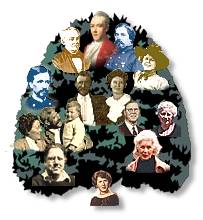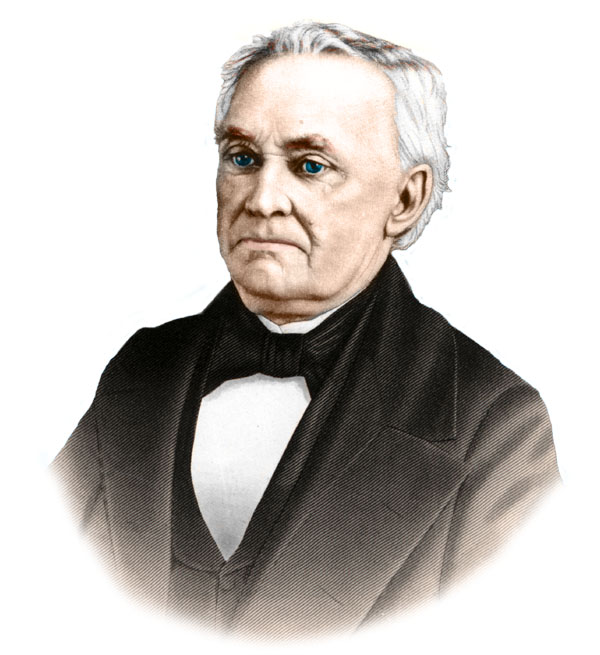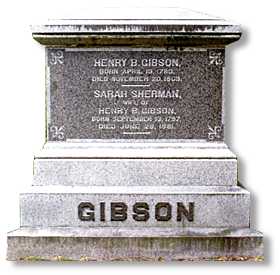|


The Gibson Branch
UPDATED 10 May 2016 |
|
Frontier Soldier; Secretary, Indiana Territory | |
|
John Gibson, frontier soldier, secretary of the Indiana Territory, was born at Lancaster, Pa., the son of George and Elizabeth (de Vinez) Gibson and the brother of George Gibson. Of his childhood and early training there is no record though in later life he exhibited a superior knowledge of Indian dialects and a studied English diction. At the age of eighteen he began his military career as a participant in the Forbes expedition (1758) which resulted in the capture of Fort Duquesne from the French. On the close of the campaign Gibson settled at Fort Duquesne (renamed Fort Pitt) as an Indian trader. This commercial enterprise met with obstacles in 1763 when, at the outbreak of Pontiac's War, Gibson, with two or three companions, was captured by the Indians near the mouth of Big Beaver Creek on the Ohio River. Some of the captives were put to death, but Gibson is said to have been saved, Pocahontas fashion, by an Indian squaw, and carried as a prisoner to the Great Kanawha River in southwest Virginia. During the year spent as a captive he was given the sobriquet "Horse-head." He may also have acquired an Indian wife, described as a sister or sister-in-law of Logan, the Mingo warrior. When Col. Bouquet secured his release in 1764 Gibson once more returned to Fort Pitt to engage in the Indian trade. In 1774 he took part in the campaign against the Shawnees, Mingoes, and Delawares known as Dunmore's War. Logan's classic but much questioned speech, an incident of Dunmore's War, was made to and reported by Gibson (Papers of Thos. Jefferson, ser. I, folio vii, nos. 153 and 198; ser. V, folio i, no. 4, in the Library of Congress), who probably supplied the flowery eloquence. The following year Gibson aided in the negotiations with the Indians which resulted in the Treaty of Pittsburgh, signed after the outbreak of the Revolution. He was named western agent for Virginia in 1775 and became a warm protagonist for the claims of that state to the territory lying between the Monongahela and Ohio Rivers known as West Augusta. As a member of the Western Pennsylvania Committee of Correspondence he was active during the early stages of the war in securing peace with the Indians, making a tour of the Ohio tribes for that purpose. He then entered the Continental service, serving under Washington in New York and during his retreat southward, until transferred to the western department. In 1776 he was made lieutenant-colonel, and the next year he was promoted colonel, which rank he held until the end of the war. During 1779 he was commandant at Fort Laurens (Bolivar, Ohio), and the next year, while aiding Baron Steuben who was in Virginia raising troops for Gen. Greene, he was named second in command of George Rogers Clark's proposed expedition into the Northwest territory, but Gen. Broadhead, the commandant at Fort Pitt, negatived the plan by refusing to release Gibson's regiment. Gibson secured his revenge when he took a prominent part in the ousting of Gen. Brodhead at Fort Pitt in 1781, and procured the command for himself until relieved by Gen. William Irvine the following year. At the close of the war he took up his residence in Allegheny County, Pa., where he served as a judge of the court of common pleas and major-general of militia. He was a member of the convention which drafted the constitution of 1790, and with Gen. Richard Butler negotiated the purchase for Pennsylvania of the "Erie Triangle" (1789) from the Iroquois Confederacy. During the Whiskey Rebellion (1794) he was an active adherent of the government, and thereby made so many enemies that he was given the "passport and guard" by his less loyal neighbors. After receiving President Jefferson's appointment as secretary of the Indiana Territory Gibson reached Vincennes in July 1800, and in the absence of the governor, W.H.Harrison, he began the organization of the territorial government, and prepared the first census report. He retained the office of secretary until 1816, but again served as acting governor during the critical period of the War of 1812. He gave invaluable aid to Gov. Harrison at the council of Vincennes with Tecumseh, and sent an expedition that relieved Capt. Zachary Taylor from a perilous position at Fort Harrison (November 1812). On the formation of the new state government Gibson returned to Pennsylvania. He died at Braddock's Field in 1822, survived by his wife, Ann Gibson. [R.G. Thwaites and Louise P. Kellogg, The Revolution on the Upper Ohio, 1775-77 (1908), and Documentary History of Dunmore's War (1905); Washington Papers, Correspondence with the Military, in the Library of Congress; Logan Esarey, ed., Messages and Letters of William Henry Harrison (2 vols., 1922); Pennsylvania Archives, 2 ser., IV (1876); "Executive Journal of Indiana Territory," in Indiana History Soc. Pubs., vol. III, no. 3 (1900); E.B. O'Callaghan, ed., Docs. Relative to the Colonial History of the State of New York, VIII (1857), 464; Louise P. Kellogg, Frontier Retreat on the Upper Ohio, 1779-81 (1917); Thos. Jefferson, Notes on Virginia (1801); C.A. Hanna, The Wilderness Trail (2 vols., 1911); Thomas P. Roberts, Memoirs of John Bannister Gibson (1890); W.W. Woolen, Biographical and Historical Sketches of Early Indiana (1883); Olden Time, Feb. 1847; West Virginia Historical Magazine, January 1903; Western Pennsylvania Historical Magazine, October 1922; Indiana Magazine of History, March 1917; Pittsburgh Gazette, April 19, 1822]
| |
|
Bank Cashier; Railroad President; Helped create New York Central | |
 Henry B. Gibson. This distinguished early citizen of Canandaigua was born in Reading, Penn, April 13, 1783. His father was John Gibson, of Irish ancestry, who removed to Saratoga, N.Y., when Henry B. was nine years of age. The son's education was principally obtained in Saratoga, a career at the bar having been designed for him by his parents; but his studies developed an unusual natural aptitude for mathematics and an inclination toward commercial life which finally determined his occupations for life. He accordingly left home at sixteen years of age for Cooperstown, where he entered the employ of the leading merchant of the place, Judge Cooper, father of James Fenimore Cooper, the famous novelist, who was Mr. Gibson's lifelong friend. After a period in the capacity of clerk, he sought a broader field by removal to Utica about 1808 with Mr. Hugh Cunningham, one of the early merchants of that village. This connection continued only a short time, when Mr. Gibson accepted employment in the county clerk's office under Francis A. Bloodgood, until 1812, when he was appointed teller in the Bank of Utica. This position he soon resigned, owing to some minor disagreement with the cashier, Washington Hunt. Mr. Gibson had already and thus early in his life set his mind fully and with characteristic determination upon becoming a successful man of business, and he clearly saw the road that must inevitably be traveled to that goal. His passing years were noted for unflagging industry, exceeding frugality for one at his time of life, and those personal habits of temperance in all things which he practiced to the end of his life. His small savings he early made to contribute to his earnings by loaning them in small amounts, evincing in such transactions the germs of the great business sagacity he afterwards displayed. In the year 1802, Watts Sherman, who afterwards became Mr. Gibson's partner in law, formed a partnership in mercantile business in Utica with Arnold Wells (as we learn from a history of that city lately edited by Dr. M.M. Bagg). Mr. Sherman was one of the pioneers of Utica, locating there in 1795, and for a time working as a cabinet-maker, but afterwards becoming a merchant. He was from Newport, Rhode Island, and descended from an old and prominent family. Mr. Sherman was more ambitious for advancement than his partner and they soon separated, Mr. Sherman largely extending his operations. He was one of the most prominent men in founding the first glass works there, with the factory at Vernon and was one of the directors of the company. Under date of May, 1813, he informed the public that he had taken into partnership Henry B. Gibson and Alexander Seymour, under the firm name of Sherman, Gibson & Co. The junior member of this firm remained and carried on the business in Utica, while Mr. Sherman and Mr. Gibson went to New York city and established a wholesale house.
Mr. Gibson's business operations in New York continued until 1819, and with reasonable success for that period.
At the end of that time, he found himself the possessor of about $30,000, a considerable fortune in those early
days when the millionaires of the country were very few in number. By the year 1813 the Ontario Bank was founded in
Canandaigua, with many of the leading men of that section included in its direction. It had started under apparently
This unbounded confidence was of such a character that in the minds of many he came to be considered a special
favorite of fortune, and it was a common expression that every operation in which he took an interest could not
fail. The calmer judgement of later years defined the elements of his success more clearly and it was seen that
success followed his undertakings wholly because he had the judgement, foresight and sagacity to see from the
beginning the sure results of following certain well known business methods; that he was successful because he
He held the office of county clerk from 1843 to 1849. He felt a deep interest in the early railroads and gave them practical aid; was president of the Auburn and Rochester Road and after the consolidation which brought into existence the New York Central he held the office of director.
His death took place in Canandaigua on the 20th of November, 1863.
Mrs. Gibson died June 28, 1881.
|





 favorable auspices; had erected in 1813 a large and imposing bank building, still standing on Main Street, and entered
into competition for the banking business of what is now Western New ork. But its affairs did not prosper as had been
anticipated and it was determined to change to some extent the management. Mr. Gibson's reputation as a skillful and
prudent financier had preceded him to Ontario County, and indeed was more or less known through his New York commercial
connections throughout the State. The result was that he was invited to accept the cashiership of this bank, which he
did and entered upon his duties in 1820. It is more than probable that his acceptance of this office in a bank located
in a rural community, where the actual payment for his services could not possibly approach in amount what he might
reasonably hope to gain in business in the metropolis, was prompted to a large extent by his predilection for that
highest of all commercial occupation, the conduct of a bank and the possibilities thereby opened for the exhibition
of financial skill and large financial transactions. Mr. Gibson attacked the task before him of placing the affairs
of the Ontario Bank upon a foundation that would commend it to the business community and secure the confidence of
depositors, with the utmost vigor and all of his accustomed industry. That he was from the first and during all of
his long connection with the institution eminently successful, is only another evidence of his thorough fitness for
such a post and his consummate ability as a financier; while his personal characteristics were such as to win for
him in all business circles the utmost confidence.
favorable auspices; had erected in 1813 a large and imposing bank building, still standing on Main Street, and entered
into competition for the banking business of what is now Western New ork. But its affairs did not prosper as had been
anticipated and it was determined to change to some extent the management. Mr. Gibson's reputation as a skillful and
prudent financier had preceded him to Ontario County, and indeed was more or less known through his New York commercial
connections throughout the State. The result was that he was invited to accept the cashiership of this bank, which he
did and entered upon his duties in 1820. It is more than probable that his acceptance of this office in a bank located
in a rural community, where the actual payment for his services could not possibly approach in amount what he might
reasonably hope to gain in business in the metropolis, was prompted to a large extent by his predilection for that
highest of all commercial occupation, the conduct of a bank and the possibilities thereby opened for the exhibition
of financial skill and large financial transactions. Mr. Gibson attacked the task before him of placing the affairs
of the Ontario Bank upon a foundation that would commend it to the business community and secure the confidence of
depositors, with the utmost vigor and all of his accustomed industry. That he was from the first and during all of
his long connection with the institution eminently successful, is only another evidence of his thorough fitness for
such a post and his consummate ability as a financier; while his personal characteristics were such as to win for
him in all business circles the utmost confidence.
 deserved to be on account of his industry, shrewdness, integrity and rigid adherence to the principles of
temperance, the latter being always kept in view by him. His bank became one of the best known and most
successful in the interior of the State, while through it and his other extensive operations he amassed one
of the largest fortunes of the time outside of the great business centers of the country.
deserved to be on account of his industry, shrewdness, integrity and rigid adherence to the principles of
temperance, the latter being always kept in view by him. His bank became one of the best known and most
successful in the interior of the State, while through it and his other extensive operations he amassed one
of the largest fortunes of the time outside of the great business centers of the country.




 Copyright © 1997, Mary S. Van Deusen
Copyright © 1997, Mary S. Van Deusen